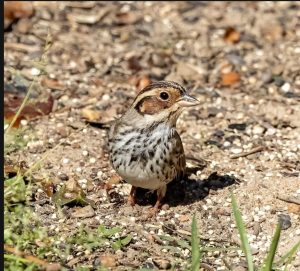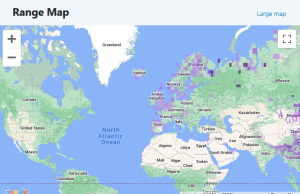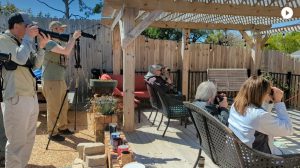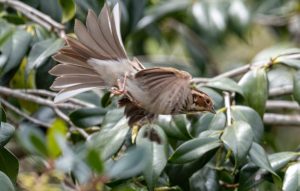
Sometimes, if we are paying close attention, the most extraordinary things can happen in our own backyards. Monica, a friend and neighbor of mine, has always been an animal lover. She routinely rescues dogs and wayward wild animals, often reaching out to me for advice on what to do. She set up some bird feeders outside a window a few months back, mostly to entertain her indoor cat. In the process, she started paying attention to and learning the types of birds that visited her yard. Last month, she messaged me asking about bird identification, as there was a small but unusual bird in her yard. I am great with trees and wetlands and fish, but I’m notoriously deficient in bird identification. So, I referred her to some colleagues with expertise. She also posted a photo on an American Birding Association social media group called “What’s This Bird?” What happened next was way beyond any casual birder’s imagination.

Turns out, the small brown and white bird strutting about her yard every morning was a little bunting (Emberiza pusilla). This species is native to northern Europe and Siberia, typically wintering in southern Asia. There are no records of the bird east of the Mississippi River; in fact, its Audubon notation says it is rare in Alaska but “made it all the way to California twice.”

Once a professional was able to confidently identify the bird, word spread like wildfire in the birding community. Monica was warned that hundreds of people might show up at her door in hopes of seeing this once-in-a-lifetime species. Thankfully, some experienced birding friends took charge, setting up a viewing schedule and vetting visitors. This way, Monica and her family could go about their lives while allowing the visiting birders to experience something they never expected. Over the span of a month, over 100 birders visited her yard, coming from all over the southeast and as far away as Canada. The bird, nicknamed “Birt” (bird+dirt, for its habit of kicking around in the dirt for food), returned daily and 99% of the visiting birders were able to see this rare find. He finally flew off for good a month ago, after spending March 1st-26th in her yard. The best guess is that he will migrate out to spend the summer in Alaska.

Little buntings are tough little birds, living and breeding in the freezing open sub-Arctic taiga regions of northern European and Asian countries. They are identifiable by the white and reddish-brown striping pattern on their faces and upper wings. They bear some resemblance to the Savannah sparrow, which can be differentiated by its yellow face markings. The species typically nests close to the ground or in lower areas like clumping grasses or tree stumps. Females and males share the duties of egg incubation, usually a clutch of 4-6 eggs. Migrating south during the winter, little buntings feed on insects and seeds in open forests and grassy areas.
While it is unlikely we will ever see another wayward little bunting in our area again, it never hurts to keep your eyes open! Sometimes the most remarkable things can be found in the most unexpected places.
Note: All images and contents are the property of UF/IFAS.
Source: UF/IFAS Pest Alert



